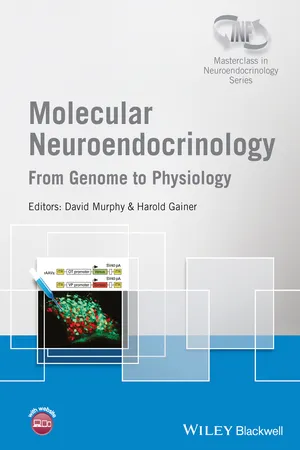
- English
- ePUB (mobile friendly)
- Available on iOS & Android
About This Book
Molecular Neuroendocrinology: From Genome to Physiology, provides researchers and students with a critical examination of the steps being taken to decipher genome complexity in the context of the expression, regulation and physiological functions of genes in neuroendocrine systems.
The 19 chapters are divided into four sectors: A) describes and explores the genome, its evolution, expression and the mechanisms that contribute to protein, and hence biological, diversity. B) discusses the mechanisms that enhance peptide and protein diversity beyond what is encoded in the genome through post-translational modification. C) considers the molecular tools that today's neuroendocrinologists can use to study the regulation and function of neuroendocrine genes within the context of the intact organism. D) presents a range of case studies that exemplify the state-of-the-art application of genomic technologies in physiological and behavioural experiments that seek to better understand complex biological processes.
•Written by a team of internationally renowned researchers
•Both print and enhanced e-book versions are available
•Illustrated in full colour throughout
This is the third volume in a new Series 'Masterclass in Neuroendocrinology', a co- publication between Wiley and the INF (International Neuroendocrine Federation) that aims to illustrate highest standards and encourage the use of the latest technologies in basic and clinical research and hopes to provide inspiration for further exploration into the exciting field of neuroendocrinology.
Series Editors: John A. Russell, University of Edinburgh, UK and William E. Armstrong, The University of Tennessee, USA
Frequently asked questions
Information
Part A
Genome and Genome Expression
CHAPTER 1
Evolutionary Aspects of Physiological Function and Molecular Diversity of the Oxytocin/Vasopressin Signaling System
1.1 Evolution of peptidergic signaling
1.1.1 Evolution and diversity of peptide G protein-coupled receptors and their endogenous ligands
Table of contents
- Cover
- Title Page
- Table of Contents
- List of Contributors
- Series Preface
- About the Companion Website
- Introduction
- Part A: Genome and Genome Expression
- Part B: Proteins, Posttranslational Mechanisms, and Receptors
- Part C: The Tool Kit
- Part D: Case Studies – Integration and Translation
- Glossary
- Index
- End User License Agreement